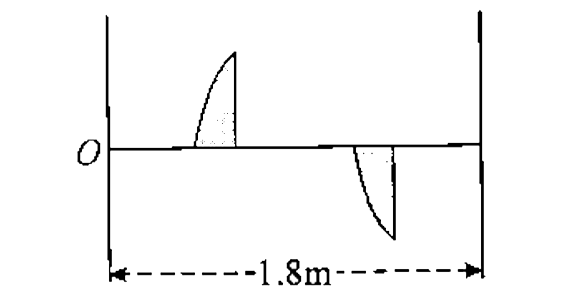In the figure shown, find the relative speed of a approach/ separation of the two final images formed after the light rays pass through the lens, at the moment when u = 30 cm . The speed of object = 4 cm/s . The two lens halves are placed symmetrically w.r.t. the moving object
_E01_157_Q01.png)
The correct Answer is:(85)cm/s
I0=m=vu=ff+u,rel2dIdt=[−f0(f+u)2dudt]×2
=−40×1210×10×4×2=−85cm/sec
Topper's Solved these Questions
- GEOMETRICAL OPTICSBOOK - ALLENCHAPTER - GEOMETRICAL OPTICSEXERCISE - EXERCISE-05 (A)
35 Videos
- GEOMETRICAL OPTICSBOOK - ALLENCHAPTER - GEOMETRICAL OPTICSEXERCISE - EXERCISE-05 (B)
35 Videos
- GEOMETRICAL OPTICSBOOK - ALLENCHAPTER - GEOMETRICAL OPTICSEXERCISE - EXERCISE-04[A]
23 Videos
- CURRENT ELECTRICITYBOOK - ALLENCHAPTER - CURRENT ELECTRICITYEXERCISE - EX.II
66 Videos
- GRAVITATIONBOOK - ALLENCHAPTER - GRAVITATIONEXERCISE - EXERCISE 4
9 Videos
Similar Questions

If the distance between two images formed by upper and lower part of the lens of the point object placed at 30 cm from given lens is 11n (in cm) then find n:
View SolutionWhen a real object is placed 25cm from a lens, a real image if formed. Mark the correct statement(s) from the following:
View SolutionTwo particles P and Q are moving as shown in the figure. At this moment of time the angular speed of P w.r.t. Q is

View SolutionThe figure below shows the positions of a point object 0, two lenses, a plane mirror and the final image I which coincides with the object. The focal length of the convex lens is 20 cm. Calculate the focal length of the concave lens.

View SolutionIn displacement method, the distance between object and screen is 96cm. The ratio of lengths of two images formed by a converging lens placed between them is 4. Then,
View SolutionWhen an object is kept at a distance of 30cm from a concave mirror, the image is formed at a distance of 10 cm. if the object is moved with a speed of 9 cm/s, find the speed (in cm/s) with which image moves.
View SolutionA thin plano-convex lens of focal length f is split into two halves. One of the halves is shifted along the optical axis as shown in figure. The separation between object and image planes is 1.8 m. The magnification of the image, formed by one of the ball lens is 2. Find the focal length of the lens and separation between the two halves. Draw the ray diagram for image formation.

View SolutionThe redius of curvature of the convex face of a plano-convex lens is 12cm and its refractive index is 1.5.
a. Find the focal length of this lens. The plane surface of the lens is now silvered.
b. At what distance form the lans will parallel rays incident on the convex face converge?
c. Sketch the ray diagram to locate the image, when a point object is places on the axis 20cm from the lens.
d. Calculate the image distance when the object is placed as in (c).
View SolutionA 4 cm tall object is placed on the principal axis of a convex lens. The distance of the
object from the optical centre of the lens 12 cm and its sharp image is formed at a
distance of 24 cm from it on a screen on the lens, in the which ways (towards the lens or away from the lens) will he have to move the screen to get a sharp image of the object on it again? How will the magnification of the image be affected ? .
View Solution(a) In the figure shown a slab of refractive index 32 is moved toward a stationary observer with speed 6cm/s . A point O is observed by the observer with the help of paraxial rays through the slab. Both O and observer lie in are. Find the velocity (in cm/s) with which the image will appear to move to observer.

(b) in the previous question if the object moves towards rigth with a velocity of 6cm/s and find the velocity of the final image (in cm/s) as seen by observer :
View Solution
